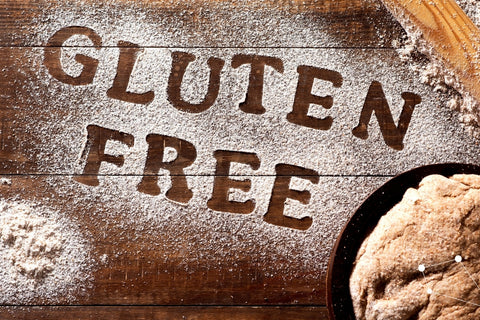What is coeliac disease?
Coeliac disease is an autoimmune condition that affects the small intestine. When someone who is celiac consumes gluten the body reacts with an inappropriate immune response, causing inflammation and damage to the small intestine. The villi (pictured below) are tiny finger-like projections that line the bowel. When they are healthy you can see that they are easily identifiable, separate from each other and rich in colour. When they are damaged, known as villous atrophy, they become flattened and inflamed (pictured below). This atrophy affects nutrient absorption by reducing the surface area of the bowel, leading to symptoms resulting from malabsorption and gastrointestinal issues.
Image: villi
Image: villous atrophy
Healthy Villi, Damaged Villi
Coeliac disease affects approximately 1% of the Australian population, however for every case that is diagnosed, there is thought to be between 5-10 cases that are undiagnosed. It is a chronic disease and only treatable with the removal of gluten from the diet. Once gluten has been removed, the lining of the small intestine is able to begin to heal and symptoms will begin to reduce.
When identifying coeliac disease, serological screening (anti-transglutaminase IgA antibody (TTG) and multiple duodenal biopsies are required. Its key genetic identifiers are human leukocyte antigen (HLA) - DQ2 and DQ8 genes. It is important to note that roughly 50% of the population carries either one or both of these genes but approximately only 1 in 40 will end up being diagnosed with coeliac disease. If there is a parent, sibling or child in the family who has coeliac disease, immediate relatives have a 10% chance of also having the disease. So it is important to have all family members screened for the disease if this is the case. Gluten challenges are used in patients that are genetically predisposed that may have already been following a gluten free diet prior to testing. This requires adding gluten containing foods back into the diet for 14 days, under the supervision of your general practitioner or healthcare professional prior to testing.
What is gluten?
Gluten belongs to a family of proteins called prolamins, including gliadin and glutenin that are the starchy endosperm of grains including wheat, barley, rye, kamut, and spelt. It is important to note that oats can also contain gluten. After consumption, the prolamins within gluten are digested within the small intestinal lumen, however, these proteins are rich in two amino acids, proline and glutamine, which make it difficult to digest. People affected by coeliac disease are genetically predisposed to developing abnormal immune responses to the undigested gluten proteins.
Symptoms of Coeliac Disease
Some of the typical intestinal symptoms of coeliac disease include abdominal distention and discomfort, chronic diarrhoea, nausea, constipation, loss of appetite and weight loss. Children affected with coeliac disease may be affected by failure to thrive, leaving them underweight and malnourished. Common extra-intestinal symptoms seen in both children and adults stemming from either malabsorption and/or chronic inflammation include iron deficiency anaemia and macrocytic anaemia due to vitamin B12 and/or folate deficiency. Calcium and Vitamin D3 malabsorption can also cause alterations in bone mineral density resulting in osteoporosis and osteopenia.
Some neurological symptoms associated with coeliac disease include headaches, fatigue, anxiety, depression, neuroinflammation and paraesthesia (altered sensation). Changes in reproductive function have also been noted including late menarche (timing of the first menstrual period), recurrent miscarriages, amenorrhoea (lack of menstrual periods), premature birth and changes to spermatozoa (motility and number). Most, if not all manifestations have been shown to reverse when a strict gluten free diet is followed.
Autoimmune conditions and coeliac disease
Coeliac disease is associated with an increased prevalence of autoimmune diseases, including but not limited to, type 1 diabetes, autoimmune thyroid diseases, liver diseases, and a skin condition known as dermatitis herpetiformis.
Similarities have been found between coeliac disease and type 1 diabetes including the genes HLA DQ2 and HLA DG8. Approximately 90% of individuals with T1DM will have either DQ2 gene or DG8, compared to 40% of the general population. Following a gluten free diet for patients suffering from both conditions has been shown to improve metabolic control in diabetes and confer protective effects for prevention of vascular complications.
Autoimmune thyroid conditions, like Grave’s Disease and Hashimoto’s thyroiditis have a 2-7% risk of developing coeliac disease. An increased prevalence of coeliac disease is reported in thyroid disease and type 1 diabetes and may adversely affect metabolism, growth and fertility in these people.
Abnormalities from the liver are common in coeliac disease patients, however, once a gluten free diet is consumed they usually resolve spontaneously. Emerging studies have shown associations between autoimmune liver diseases (e.g. primary biliary cirrhosis, autoimmune hepatitis and primary sclerosing cholangitis) and coeliac diseases. This is thought to be due to a disruptions in the gut-liver axis.
Dermatitis Herpetiformis (DH) is an inflammatory disease of the skin which is characterised clinically by intense pruritic polymorphic lesions. DH is seen in 25% of patients with coeliac disease and can be known as the “visiting card” in coeliac patients because they generally only appear in those individuals. One explanation for these lesions is thought to be related to the presence of chronic and active inflammation of the mucosal lining of the small bowel from consistent challenging with gluten. This localised immune response results in mucosal IgA binding to the skin, eventually producing lesions. However the pathophysiology of DH can be due to a number of factors including HLA predisposition (genetic), triggered from environmental sources (gluten) and immune system dysregulation. Family screening for coeliac disease in patients affected by DH is strongly recommended and malabsorption should be monitored in untreated patients.
I think I'm gluten intolerant, but have tested negative for Coeliac Disease. What other conditions could I have?
Non-Coeliac Gluten Sensitivity
Non-coeliac gluten sensitivity is characterised by extra-intestinal (symptoms not affecting the intestine) as well as intestinal symptoms relating to the ingestion of gluten containing foods where wheat allergy and coeliac disease have been ruled out (absence of antibodies). In 2018 the Digestive Health and Wellbeing Survey was conducted in Australia to determine the incidence of self-reported non-coeliac wheat sensitivity (SR-NCWS) showing that this condition affects nearly 1 in 7 adult Australians.
Symptoms can include fatigue. headaches, brain fog, joint pain, numbness in limbs as well as pain, gas, bloating, altered bowel habits and skin manifestations. Gluten sensitivity has not been shown to adversely affect intestinal permeability and does not stimulate increased tissue-transglutaminase, endomysium or deamidated gliadin antibodies.
Wheat Allergy
Wheat Allergy (WA) refers to an immunological reaction to the proteins contained in wheat and wheat related grains. Inflammatory responses are caused by immunoglobulin E (IgE) antibodies in relation to several allergenic proteins. The type of symptom response depends on the route of the allergen exposure. For example, someone with a wheat allergy may suffer from occupational asthma and rhinitis; food allergies affecting the skin, respiratory tract or gastrointestinal tract; or exercise-induced anaphylaxis which is dependent on wheat. WA can occur in both children and adults. Diagnosis of a WA is via skin prick tests, as well as functional and in-vitro IgE assays.
Gluten free diets - are they healthy?
Many Australian’s who are not diagnosed with coeliac disease choose to follow a gluten free diet, due to reports of ‘gluten ingestion’ symptoms when gluten is consumed, or due to its presumed health benefits. The concern that diets containing gluten have negative health impacts, even if there is no gluten-associated disease found, has reached 30% of the population of developed Western countries. Some consumers opt to follow a gluten free diet as they believe it may assist them in losing weight. In the 2018 Digestive Health and Wellbeing survey, 316 individuals out of 1304 participants reported gluten avoidance with partial avoidance reported in 267 people and complete avoidance in 49 participants. 168 participants avoided wheat/gluten for general health reasons, 123 for abdominal symptoms and 109 to assist in weight loss.
These days, following a gluten free diet is relatively easy and there are many alternatives to ‘gluten containing’ foods e.g. gluten free breads, pastas, baked goods, flours and cereals. Studies have shown that these gluten-free foods contain reduced levels of protein, fibre, iron, vitamins (including folic acid, niacin, thiamine and riboflavin) and higher in carbohydrates and fat. This is compared to gluten containing food that is naturally high in these nutrients. In fact, some gluten free bread contains a fat content that is 2-fold higher than wheat bread and gluten free pasta can contain higher levels of carbohydrates and sodium than wheat pasta.
Some individuals who consume gluten free diets have been shown to have inadequate intakes of vitamin A, vitamin D, vitamin B12, iron, magnesium, zinc, folic acid, selenium, calcium, niacin and thiamine. After a 10 year period, coeliac patients consuming a gluten free diet had increased levels of homocysteine - a compound associated with higher rates of blood vessel disease. However significant improvements in gastrointestinal mucosa was also reported. It is for such reasons that a gluten free diet is not recommended for those who do not suffer from gluten-related conditions, unless confirmed by a healthcare practitioner. Gluten free diets should also not be used as a way of losing weight or to become healthier unless of course you are medically advised to do so. If this is the case, you should consult a dietitian who has extensive knowledge and training in this subject who can provide advice on sufficient macro- and micro- nutrient intake where necessary.
Which foods are safe for coeliac disease?
Coeliac Australia endorses foods with a gluten-free logo displayed on foods and products that have been tested and are suitable for people with coeliac disease (as seen below). Any foods that are naturally gluten-free like fresh fruit, vegetables, meats, nuts, eggs, legumes, milk, oils, fats, rice and corn are suitable to be consumed without harm. You can also find an array of products in supermarkets and health food stores that are labelled as ‘gluten free’ that will provide you with confidence in knowing they contain no detectable gluten and are safe to eat.
Which foods should be avoided in coeliac disease?
All gluten containing foods (wheat, rye, barley, spelt, kamut, and oats) must be strictly avoided to prevent any complications of coeliac disease. Food packaging must declare if there is any trace of gluten.
Cross-Contamination
Following a confirmed diagnosis of coeliac disease, it is extremely important to avoid any cross contamination. Even small amounts of gluten ingested can continue to cause damage to the gastrointestinal tract and/or cause symptoms associated with coeliac disease. Examples of cross-contamination where an item of gluten free food is contaminated by direct or indirect contact with a product containing gluten may include using the same knife to spread onto gluten free bread from gluten containing bread; or using a toaster or grill that has had gluten ingredients on it without completely cleaning it.
Coeliac Australia has a great list of tips to avoid cross contamination:
- “Store gluten free containing foods separately and labelled clearly, especially if removed from original packaging
- Have dedicated butters and spreads for gluten free use, or implement a ‘no double dipping’ policy
- Have a separate toaster or use a clean sandwich press/grill.
- Use separate water in a clean pot for cooking or reheating gluten free pasta. Use a separate colander for gluten free pasta or drain it first
- Thoroughly clean chopped boards, knives and other cooking utensils used in food preparation
- Do not dust meats or fish with gluten containing flour (including wheaten cornflour)
- Icing sugar mixture can contain wheat, ensure you choose gluten free icing sugar/flour. Keep this in mind when dusting cakes and slices.
- Clean oil should be used when deep frying. If sharing with family, make sure the gluten free item is fired first and then fry the gluten containing items”
Dining Out
Dining out can be extremely overwhelming and may cause significant anxiety for those diagnosed with coeliac disease. The best thing one can do is to be prepared. There are a number of restaurants/cafes that provide gluten-free options on the menu, however if you would like to be sure, you can always call ahead to double check and let them know that they will have someone suffering from coeliac disease dining at their restaurant; and to ask if they able to cater to this dietary requirement. Some cuisines that are naturally gluten-free and tend to populate a larger proportion of the menu include indian, mexican, thai and vietnamese foods.
References:
1. Barbaro, M. R., Cremon, C., Stanghellini, V., & Barbara, G. (2018). Recent advances in understanding non-celiac gluten sensitivity. F1000Research, 7, F1000 Faculty Rev-1631. https://doi.org/10.12688/f1000research.15849.1
2. Coeliac Australia - Coeliac Disease https://www.coeliac.org.au/s/coeliac-disease
3. Caio, G., Volta, U., Sapone, A., Leffler, D. A., De Giorgio, R., Catassi, C., & Fasano, A. (2019). Celiac disease: a comprehensive current review. BMC medicine, 17(1), 142. https://doi.org/10.1186/s12916-019-1380-z
4. Gujral, N., Freeman, H. J., & Thomson, A. B. (2012). Celiac disease: prevalence, diagnosis, pathogenesis and treatment. World journal of gastroenterology, 18(42), 6036–6059. https://doi.org/10.3748/wjg.v18.i42.6036
5. Jones A. L. (2017). The Gluten-Free Diet: Fad or Necessity?. Diabetes spectrum : a publication of the American Diabetes Association, 30(2), 118–123. https://doi.org/10.2337/ds16-0022
Kutlu T. (2019). Gluten-free diet: is it really always beneficial?. Turk pediatri arsivi, 54(2), 73–75. https://doi.org/10.14744/TurkPediatriArs.2019.82609
6. Lauret, E., & Rodrigo, L. (2013). Celiac disease and autoimmune-associated conditions. BioMed research international, 2013, 127589. https://doi.org/10.1155/2013/127589
7. Potter, M., Jones, M., Walker, M., Koloski, N., Keely, S., Holtmann, G., Talley, N. (2020). Incidence and prevalence of self-reported non-coeliac wheat sensitivity and gluten avoidance in Australia. The Medical Journal of Australia, 212 (3):126-131. https://www.mja.com.au/journal/2020/212/3/incidence-and-prevalence-self-reported-non-coeliac-wheat-sensitivity-and-gluten
8. Posner EB, Haseeb M. Celiac Disease. [Updated 2020 Nov 20]. In: StatPearls [Internet]. Treasure Island (FL): StatPearls Publishing; 2021 Jan-. Available from: https://www.ncbi.nlm.nih.gov/books/NBK441900/


